Male devices are divided into products that are designed to collect and contain bladder leakage (sheaths, body-worn urinals and devices for penile retraction) and products designed to prevent bladder leakage (penile clamp or penile compression device).
Use the Product Advisor for help choosing between the different types of device.
Sheaths
What is a sheath?
A sheath is very similar to a contraceptive condom. It fits over the penis and collects urine as it leaves the body. You may also hear them called condom catheters, uridomes, Texas catheters or external catheters. They can be connected to a drainage bag or alternatively a catheter valve if leakage is very light.
1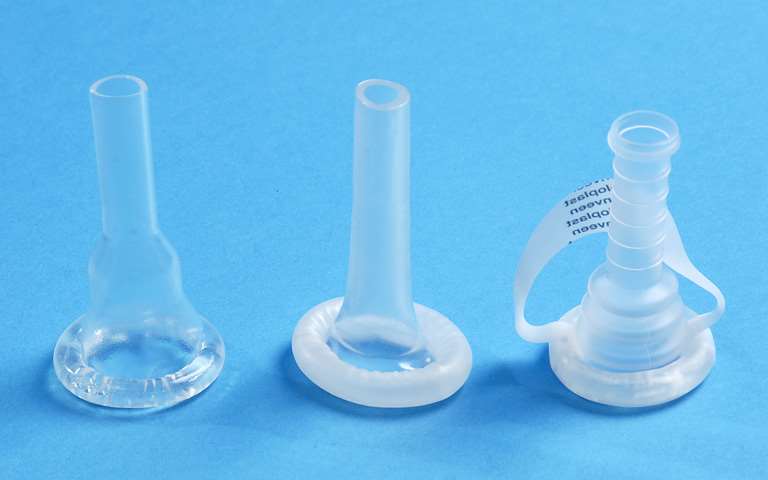
Sheaths
| More likely to suit you if... |
Less likely to suit you if... |
- You have bladder leakage or experience frequent or urgent need to urinate
|
- You have skin damage on or around the penis
|
- You wish to avoid using pads
|
- Urinary tract infection is a major concern for you
|
- Using a device is acceptable to you
|
- You experience poor memory or confusion
|
- You have found indwelling catheters to be uncomfortable (sheaths tend to be more comfortable than indwelling catheters)
|
- You or your helper are unwilling or unable to fit the sheath
|
- You have had a problem with infection with indwelling catheters (sheaths are associated with less infection than indwelling catheters)
|
- You have a short or retracted penis, in which case products designed specifically for this purpose may work better. See the section below on Devices for penile retraction
|
- You have good hand control
|
|
- You have good memory and mental function
|
|
When do sheaths work best?
A sheath is useful if you are active and want to go out for longer periods of time without access to a toilet or where pad changing is difficult e.g. long walks, playing golf or long journeys by plane, train or car.1 Sheaths can be used by men who also practice intermittent catheterisation.
Sheaths may also be useful at night as an alternative to pads, which do not always absorb urine effectively particularly if you sleep on your side. The sheath can be connected to a large capacity urine collection bag to cope with the large volumes of urine that some men leak at night.
What about fitting?
The most popular and frequently-used sheath design is a ‘one-piece’ sheath; these have an adhesive portion on the inside which, when the sheath is rolled onto the shaft of the penis, secures it in place. Warming by holding the sheath with the hand encourages adhesion. ‘Two-piece’ sheaths do not have integral adhesive. They are secured in place with a separate adhesive strip and/or an external Velcro band. Modified sheaths that attach to the tip or glans of the penis for penile retraction are available, which are useful for men with penile retraction.
Men who use sheaths report that they should be effective at urine collection without leakage, comfortable to wear and easy to apply and remove. It may be worth trying several types before deciding which is best for you.2
Getting the correct size and fit are critical to the sheath staying in place and preventing skin problems. Before using sheaths for the first time we recommend that you seek advice from a healthcare professional or sheath manufacturer. Most manufacturers will provide a measuring tool to help you select the correct size and may have a helpline or specialist nurse advisor who will also be able to advise you. In some countries, there are local nurse continence specialists who may be able to help with fitting.34
What other products could ‘mix and match’ well with a sheath?
Men often prefer to use sheaths as part of a combination of products:
-
Pads are the most commonly used incontinence product. Some men use a sheath system during the day and a pad at night.
-
Clamps are useful for activities where a sheath is less suitable, such as sports or swimming.
-
A body-worn urinal may be a useful alternative if you are mainly standing or walking and wish to avoid using a product with adhesive.
Use the Product selector for more help choosing between the different types of products available.
More Information about sheaths
Many men are not aware that sheaths exist and some health care professionals may be reluctant to fit them. This may be due to embarrassment on the part of either or both the health care professional and the consumer.
However, the potential benefits are worth overcoming the embarrassment. It has been reported that sheaths are associated with less pain, discomfort and trauma than indwelling catheters.19
If you wish to try sheaths to manage your incontinence it is important that you consult someone with sufficient knowledge about their selection and use. Many men who want to try to use sheaths do so without guidance from someone familiar with their use, which can result in incorrect fitting and application and subsequent poor performance and even skin damage.120
Specialist continence nurses are more likely to have the knowledge and skills required to help you to select and fit sheaths, so that they have the best chance of functioning successfully. They are also more likely to be able to discuss any sensitive issues and questions you may have about use of sheaths. Manufacturers often employ specialist helpline nurses who will give advice and in some cases be able to visit you at home.
However, many health professionals continue to have a lack of knowledge about sheath use, and, as a result, even some resistance to their use.21
Sheaths are usually made from latex or silicone rubber. Most men prefer silicone sheaths over latex ones.5 Silicone products are transparent and some men prefer this as they can see the condition of the skin under the sheath. Silicone sheaths are reported to be less likely to come off because of high urine flow rates.5
Most companies supply sheaths with a wide range of diameters from about 20-40mm (in 5-10mm increments). They are also available in different lengths and in the case of self-adhesive sheaths, with the adhesive band in different widths. This variety ensures that there is a sheath that is the correct size for you. Choosing the correct size is important for achieving a secure fit without the sheath being too tight. It is also very important for comfort, safety and effective containment of leakage.
A sheath and drainage bag that work well for one man may not work well for another.6 Free samples are often available through health professionals or the manufacturers, so it is a good idea to try more than one combination until you are confident that you have the best combination for you.
Putting a sheath on
Men with good use of their hands usually find sheaths easy to apply. Sheath manufacturers usually supply instructions for their application, and these should be followed.
When fitted, sheaths should be leak-free, secure and comfortable. They can come off the penis accidentally, but you can reduce the risk of this happening by careful application of a well-chosen product.
Some sheaths are self-adhesive and are simply rolled over the penis. Others have separate adhesive strips or other securing devices. One-piece sheaths with an integral adhesive are generally easier to use than sheaths with separate adhesive strip or other securing methods.5
Maintaining good genital hygiene is important. Prior to applying a new sheath, the penis should be washed thoroughly with soap and water and dried. Any adhesive residue on the skin should be removed. Special skin wipes or barrier cream can be used to protect the skin, but you should allow the skin time to dry and cream to be absorbed before putting the new sheath on. Avoid petroleum-based products (e.g. Vaseline), which can damage the sheath and prevent adhesion. If you are having difficulty with adhesion, try not using your usual protective product for a while or try a different product.
Pubic hair can sometimes be caught in the sheath or stuck to the adhesive, causing discomfort. It may help to trim the hair or to hold it away from the penis while putting on a sheath.
When fitting the sheath, a small gap should be left between the end of the penis and the sheath where it connects with the drainage tube. This is to avoid rubbing the end of the penis. However, a gap that is too large may increase the risk of the sheath twisting or kinking, which could impede free drainage of the urine into the drainage bag and lead to the sheath coming off.7 You may have to practice with a few sheaths until you get the positioning right.
Sheaths are usually designed to be used for up to 24 hours. Some brands may be suitable for longer wear times – you should follow the manufacturer’s instructions about this.
Urine collection
Once the sheath is in place, it should be connected to a urine collection bag. There are many designs of collection bag available, from small thigh bags to larger bags that can be worn on the calf. It is worth looking at a range of product manufacturers to find a product to suit you.
Body-worn collection bags are usually secured to the leg with straps or specially designed garments. Fitting the collection bag and drainage tubing securely is important as a collection bag heavy with urine may pull down on the sheath risking disconnection and leakage.8910
While wearing a sheath it is advisable to occasionally check that the outlet end of the sheath is not twisted and that urine can flow freely into the drainage bag tube. Some sheaths have features that are intended to reduce the possibility of twisting.
If leakage is very light or during brief activities (such as swimming), some men connect a catheter valve or other plug to the sheath. The sheath can contain small amounts of urine leakage until the valve is opened or plug removed. Find out more about catheter valves.
Taking a sheath off
Generally, if you have used the sheath for the whole day it should come off easily and you should be able to wash away any residue of adhesive. If you find removing the sheath uncomfortable, try doing this in the bath or bathing the penis in warm soapy water.
Using a sheath when you do intermittent catheterisation
Sheaths can be used if you do intermittent catheterisation. Try using a non-adhesive sheath which is secured with a foam band secured around the outside of the sheath. This is easy to remove and reapply if you need to do intermittent catheterisation during the day. Sheaths with a removable end are also available to allow for the catheter to be passed without the need to remove the sheath.
Disposal
Sheaths can usually be placed in a small bag and disposed of in the normal household waste. In some regions it may be necessary to contact your local waste collection service to find out about any specific requirements.
If you are staying away from home you will need to plan in advance how to dispose of products discreetly. However, men find sheaths easier to dispose of than pads especially when away from home.1
Disadvantages of sheaths
Sheaths do not suit all men and can be associated with some potential problems. Sexual activity may be limited by use of a sheath and a pad may be more useful at times for this reason. Alternatively, the use of a non-adhesive sheath that can be removed and reapplied relatively easily might be easier.
Skin damage
Skin damage can occur through use of sheaths.11 The risk can be minimised by removing and changing the sheath periodically according to the manufacturer’s instructions. The skin of the penis should be kept very clean with unscented soap and water and regularly examined, particularly on the underside of the penis.
Some people have an allergy to latex which can lead to skin reddening and irritation, and a more severe allergy could occur. Routinely checking skin condition is important because you may not know you have an allergy until you try latex products, and you may also develop a latex allergy over time by using them. Hypo-allergenic silicone sheaths may be preferable for this instead.
Compression damage can occur if the sheath is too tight.11 Ensure the sheath is the correct fit according to the measuring guide supplied with the sheath. If there is any swelling of the portion of the penis that is inside the sheath, the sheath is probably too tight and should be removed immediately.
Urinary tract infection can occur with sheath use1213 (although to a lesser extent than with urinary catheters14), as can skin infection or polyps1015. The risk of infection can be reduced by preventing the sheath or drainage tubing from kinking, thereby ensuring free flow of the urine from the bladder into the collection bag. Some sheaths have features intended to prevent kinking or twisting to ensure good drainage. Regular, thorough genital hygiene is also important for reducing the risk of infection.
Other health issues may mean that sheaths are an unsuitable choice for management of incontinence. Decreased sensation associated with neurological damage such as spinal cord injury may result in a lack of awareness of damage occurring to the skin. Sheaths may also be unsuitable for men who are confused or considered psychologically vulnerable. Tugging at the sheath may result in disconnection or increase the risk of urinary tract infection.491617
Where can I get sheaths?
Sheaths may be purchased through retail outlets such as supermarkets, chemists or directly from the manufacturer by phone or on the internet. Look at the list of suppliers to find out how to obtain sheaths where you are. In some countries you may be able to get sheaths on prescription from your family doctor. However, they may not have much knowledge about sheaths, so it may be helpful if you do some of your own research about different types and brands of sheaths. You can find out the types of sheath that are available online, get samples from manufacturers and, use their sizing tool, to work out the correct size for you.
Some of the larger sheath suppliers offer 'home delivery services'. This means they can deal with your GP directly and if your sheath prescription is placed on your repeat prescription list. You can order through the company and they will arrange to have the products delivered directly to your door. Remember that you do not have to order everything from one company, you may find that you like a sheath made by one company and a leg bag made by another, they all have universal fittings so you can find the combination of products that works for you.
It is necessary to plan ahead so that you have a supply on hand at all times. Often sheaths are supplied in boxes of thirty: a month’s supply based on one sheath per day.
Penile Clamps (Penile Compression Devices)
What is a penile clamp?
A penile clamp (commonly called a ‘clamp’ and also known as a 'penile compression device') is a small reusable device. Clamps work by compressing or squeezing the urethra which runs along the underside of the penis and through which urine leaves the body. Clamps are available in several different designs including a hinge design that is closed over the penis, a strap or an inflatable cuff that goes around the penis. Clamps can work well for some active men who want a discreet product during the daytime. However, some men find them uncomfortable to wear and they can reduce blood flow in the penis.18
2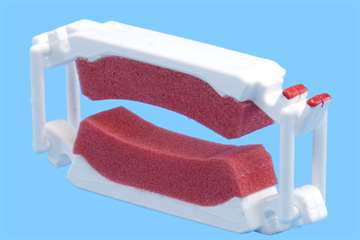
Penile compression device 21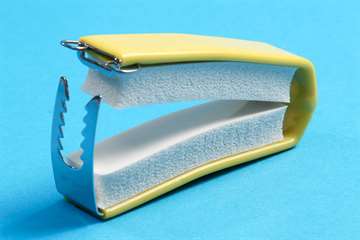
Penile compression device
| More likely to suit you if... |
Less likely to suit you if... |
|
- Your leakage is mainly associated with overactive bladder or urgency
|
- You have good sensation of your bladder filling so that you will recognise the need to pass urine
|
- You usually do not get the sensation of needing to empty your bladder
|
- You have good sensation of your penis so that you can respond to any discomfort
|
- You have poor sensation of your penis
|
- You have sufficient hand function to release the clamp
|
- You have poor hand control
|
- You have good memory, so that you remember to release the clamp
|
|
- You wish to prevent leakage for a specific period e.g. During exercise
|
- Your skin is vulnerable to damage
|
- Using a device (as opposed to a pad) is acceptable to you
|
|
- You feel motivated to try out the compression device
|
|
When do clamps work best?
Clamps can be used to prevent bladder leakage during the daytime. They should not be used during sleep.1
Although some men are able to use them as their usual daytime product, most find they are best used for short periods of time. For example, they are very useful when undertaking an energetic activity such as dancing or swimming. Some men use them simply to reduce the amount of bladder leakage so that they can wear a smaller pad, or to extend the length of time a pad is worn.1
Clamps come in a range of designs and it may take some trial and error to find the design that suits you best. When choosing, it may be helpful to think about how the features and characteristics of different clamps may fit in with the activities that you wish to undertake. These may include: the size of the clamp; its weight; the material it is made from; and ease of opening (whether this requires one hand or two).
What about fitting?
Clamps can be hazardous if used incorrectly, so it is important to read the manufacturer's guidance for safety information. Research has shown that clamps do affect blood flow during use but this recovers within 40 minutes of removing the clamp so use of a clamp for up to one hour is likely to be safe.22 Most manufacturers recommend that the clamp is removed after 2 hours although some state longer periods.
Many of the clamps are adjustable so that 'one size fits all' although some are available in different sizes (e.g. juvenile, regular, large). If this is the case the manufacturer should provide guidance on measuring.
Health care professionals may not be familiar with clamps so it may be hard to find one who can give you advice, in which case it is best to seek advice from the product manufacturer before using the product.
Men who use clamps report that the fit of the clamp often changes during the day depending on their activity, body temperature and weather. It may therefore be necessary to readjust the clamp when you are wearing it to ensure a good fit.
You can watch a video guide below to find out more about how to fit a clamp.
What other products could ‘mix and match’ well with a clamp?
It is unlikely that a clamp will work as your sole product, and men often use them as part of a combination of products throughout the day:
-
Pads are the most commonly used incontinence product. Some men use a clamp intermittently during the day and a pad at night. Others wear a pad in combination with a clamp on a looser setting during the day in order to extend the pad wear time, or so they can use a smaller pad. Other men only use a clamp during specific activities when pads are not suitable: for example, while swimming or dancing.
-
A sheath connected to a urine collection bag is a useful alternative to pads for men. Sheaths are good for active men, wheelchair users or men with a more sedentary lifestyle.
-
A body-worn urinal may be a useful alternative if you are mainly standing or walking and wish to try a reusable product.
Where can I get a penile compression device?
These products are available direct from suppliers or on the internet. Not all products are available everywhere. Use the links below find out how to get them where you are.
Body-Worn Urinals
What is a body-worn urinal?
‘Body-worn urinal’ is a general term used to describe a wide range of male devices that are designed to collect urine as it leaves the body. They are mainly reusable, although they can have a disposable part such as a urine collection bag. They offer an alternative to a disposable sheath system and are secured in place using either straps, specially designed underwear or occasionally adhesive.
7
Body-worn urinal3
Body-worn urinal with catheter valve
| More likely to suit you if... |
Less likely to suit you if... |
- Using a device (as opposed to a pad) is acceptable to you
|
- You have a short or retracted penis, in which case products designed specifically for this purpose may work better. See the section below on Devices for penile retraction
|
- You would like to try an alternative to a sheath or would like to try a reusable product. Many body-worn urinals are reusable, so men who have to pay for their products may find this a cost-effective option for at least some of the time.
|
|
When do body-worn urinals work best?
There is limited research on these types of products but they probably work best if you are standing or walking. They do not work well when sitting or lying down. Body-worn urinals are generally less successful than sheaths and most men opt to try a sheath before trying a body-worn urinal.1
What about fitting?
Body-worn urinals are available in a range of designs. Ensuring a good, comfortable fit will improve the success of the product. One research study of one type of body-worn urinal found that expert guidance and fitting led to increased acceptability among testers and is key to the success of the product. Some manufacturers can provide specialist fitting help.1 Always ensure that you use the correct size, keep your skin clean and regularly check your skin (particularly on the underside of the penis), this will minimise the risk of skin damage that can occur.11
What other products could ‘mix and match’ well with a body-worn urinal?
It is unlikely that a body-worn urinal will work as your sole product. Men often use them as part of a combination of products throughout the day:
-
Pads are the most commonly used incontinence product. Some men use a body-worn urinal during the day and a pad at night.
-
A sheath connected to a urine collection bag is a useful alternative to pads for men. Sheaths are good for active men, wheelchair users or men with a more sedentary lifestyle.
-
A clamp is useful for activities where a body-worn urinal would not be suitable, such as sports or swimming.
Where can I get a body-worn urinal?
How you get these products and where they are available varies according to local healthcare systems. Speak to your healthcare professional or contact the supplier using the links below to find out how to get them where you are.
Devices for penile retraction
What is a penile retraction device?
These are a group of products for men who have a shortened or retracted penis. This is common in older men or those who have recently had treatment for prostate cancer.
When the penis retracts into the scrotum, it can be difficult to use a conventional sheath or body worn urinal. There are three types of products for men with a shortened penis: modified sheath, pubic pressure urinal and penile pouch.
59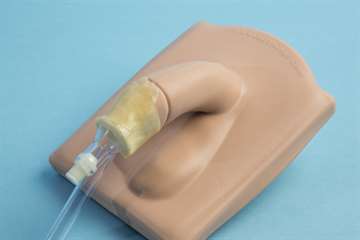
Modified sheath (petal device)le retraction)8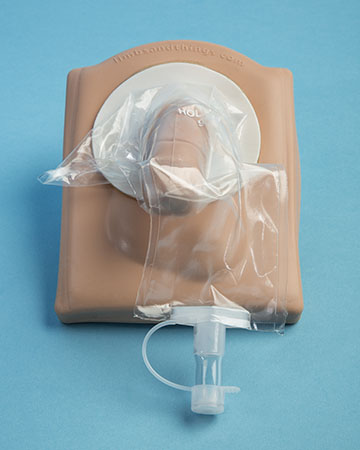
Disposable penile pouchWho are penile retraction devices good for?
They are useful for men who are unable to wear a traditional sheath or body-worn device and who wish to leave the house for longer periods when it may not be possible to access a toilet to change a pad. They may also suit men who are obese and have difficulty accessing the shaft of the penis for application of a sheath.
When do penile retraction devices work best?
There is no information based on research about how well these types of products work, and when they work best. But comparisons with other similar products suggests that modified sheaths and penile pouches are likely to perform well if you can get a good close fit and they are able to stay firmly in place. Pubic pressure urinals probably work better for activities that requires standing or walking rather than sitting or lying.
What about fitting?
Pubic pressure urinals are not a widely used product. Seeking advice from the manufacturer (who may have a helpline or specialist nurse advisor) to assist you with purchasing and fitting your pubic pressure urinal will ensure the best chance of it working for you. Modified sheaths and penile pouches are disposable products and are available as ‘one size fits all’. Manufacturers should provide advice and guidance on fitting.
What other products could ‘mix and match’ well with a penile retraction device?
It is unlikely that you will choose this as your sole product. Most men use a penile retraction device as part of a combination of products:
-
Pads are the most commonly used incontinence product. Some men use a penile retraction device during the day and a pad at night.
-
Urine directors can help if a shortened penis makes directing urine into the toilet pan difficult. A female urinal with a wide opening can also be useful.
More about the different types of retracted penis devices that are available:
Modified sheath
This is also be called a "petal device" or an "external continence device". It is made from similar (disposable) materials to a conventional sheath but it is applied just to the end (glans) of the penis rather than the whole shaft. The device has a latex-free, hydrocolloid 'plate' which sticks directly onto the end of the penis. A second adhesive strip is wrapped over the ’plate’, securing it in place. This makes it suitable for men with a shorter penile length and those who want an alternative to a traditional sheath. Unlike traditional sheaths these devices are ‘one size fits all’ so there is no need to measure your penis for the correct fit.
These are disposable devices and may be attached to a thigh/leg bag or catheter valve in exactly the same way as for sheaths. There is no current independent research evidence about how well they work, but they do offer an alternative design to overcome a common problem with sheaths for men with a retracted penis. You may find that when you start using them, you need to change them more frequently than usual while you get used to using them.
Pubic Pressure Urinals
A pubic pressure urinal is a reusable, usually latex, product. It consists of a ring which is held in place with straps or underwear in the same way as body-worn urinals. The ring is held firmly in place against the pubis; this applies pressure around the base of the penis allowing the shaft of the penis to protrude. It may then be possible for an adhesive sheath to be worn or for a non-adhesive sheath to be fitted over the ring of the pubis pressure urinal to create a water tight seal. Alternatively the cone from a traditional body worn urinal may also be used.
The companies that supply these products may provide expert guidance on fitting by a specialist to ensure effective and safe use. There is little research evidence available specifically about these devices. However research on body-worn urinals (which are a similar design) has found that they can work well for some men but the design is often seen as unappealing and they are not as well liked as sheaths and pads.
Penile Pouch
Penile pouches are small urine collection bags with an adhesive ring that sticks onto the pubic area around the penis. It is necessary to shave or trim the pubic hair in order to ensure that the adhesive can stick effectively to the skin securing the pouch in place properly. The opening can be cut to size to fit different penis widths.
Urine is collected in the pouch and emptied when convenient through a small tap at the bottom of the bag. Penile pouches are usually disposable and can be worn for 24-48 hours. There is no independent research on how well these products work, but it is likely that if you can get a good seal with the skin they should work well. It is likely that they work better in a standing position rather than seated or lying down.
Where can I get a penile retraction device?
How you get these products and where they are available varies according to local healthcare systems. Speak to your healthcare professional or contact the supplier using the links below to find out how to get them where you are.